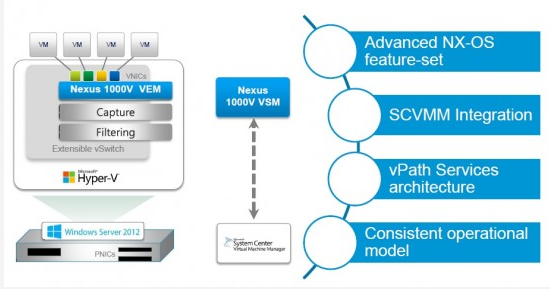Hyper-V extensible switch and Cisco Nexus 1000v
In this blog, I had discussed the advancements in Hyper-V 2012’s networking capabilities, specifically the network virtualization capabilities. With network virtualization, physical and virtual networking becomes seamless, especially when considering workloads may be bursting into a private cloud setup. One other feature that layers on top of the network virtualization capabilities is the ability for Hyper-V to provide an extensible virtual switch. Unlike standard virtual switches which have a static feature set, Microsoft built the networking framework such that third parties can be and plug extensions into the network stack. The switch driver stack allows software vendors to bind with the NDIS (Network Driver Interface Specification) interfaces. Once the extensions are installed, they are capable of capturing, filtering and forwarding the packets. This functionality hence allows vendors to provide features like firewalls, quality of service (QoS), advanced networking capabilities of switching and routing to plug into the core Hyper-V stack. The extensions are installed in the parent partition (on the host) and allow vendors to intercept the packets between the parent and the child partitions or between child partitions.
Cisco recently announced the availability of the Nexus 1000v for Hyper-V 2012. The Nexus 1000v supporting Hyper-V is significant for a few reasons:
- Cisco’s UCS (Unified Computing System) is taking the storage world by storm by having a great penetration in a market that is relatively new to Cisco.
- Cisco is known for networking and has a majority share in advanced switching equipment
- Cisco’s UCS systems are certified (and can come preconfigured) for Hyper-V, giving the Nexus 1000v further significance.
- Hyper-V is growing rapidly in market share, with a recent report indicating that it has more than 30% of the virtualization market.

Source: Cisco
The integration of the Nexus 1000v in the Hyper-V networking stack significantly reduces the operational expense of managing virtual and physical networks. The same command set utilized for managing the physical switches is compatible with the Nexus 1000v. The Nexus 1000v is deeply integrated with SCVMM (System Center Virtual Machine Manager), allowing administrators to monitor network traffic patterns between virtual machines, even during live migration of virtual machines between hypervisor hosts. This is achieved by preserving the association of port profile configurations for the virtual machine across live migration. The Nexus 1000v thus provides a truly distributed switch framework that allows a consistent set of virtual ports to be exposed to the virtual machines. These are just some of the features with Nexus 1000v. For more information, the Cisco webinar introducing Nexus 1000v is very informative, which can be viewed here.

